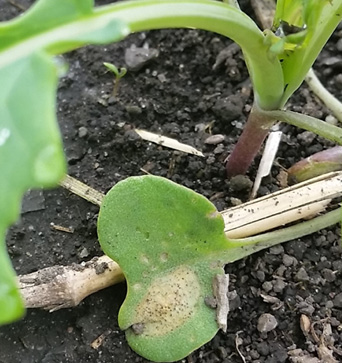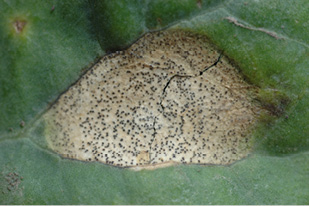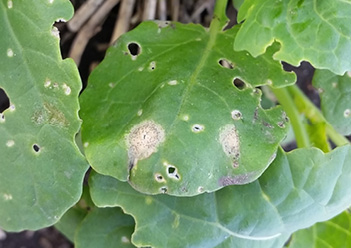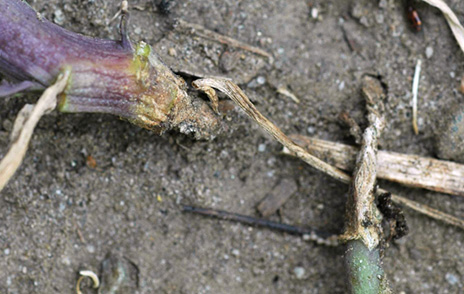Integrated pest management (IPM) strategies such as cultural practices, certified seed, seed treatment and fungicide application are highly recommended in the management of blackleg disease.
Scouting: Scouting is important to determine if management tools (such as genetic resistance) are effective. Cotyledons and lower leaves can be inspected for tan lesions with small dark-colored pepperlike structures (pycnidia) in the center. Stem cankers and vascular discoloration may be visible as the season progresses.
Resistance: Planting resistant cultivars is an essential part of blackleg management. More than a dozen resistance genes have been identified, although not all of them have been incorporated into commercial hybrids. Some seed companies are labeling their hybrids according to the resistance genes they carry. Rotation of resistance genes is important for long-term effective management. As a rule of thumb, avoid planting the same hybrid in more than two consecutive growing seasons.
Crop rotation: Two-year old canola residues produce the highest amounts of ascospores; therefore, avoid planting canola every other year if blackleg is a problem. Additionally, tight rotations can increase the speed at which the pathogen produces new races and overcomes resistance genes. A three-year rotation will help manage the disease.
Avoid canola residue: When possible, avoid planting canola close to a previous year’s crop residue. Canola stubble from previous seasons can act as important sources of inoculum for the new plantings. While 1,500 feet of separation is ideal, even shorter distances between planting will reduce the amount of spores traveling to the new crop.
Weed management: Common weeds such as shepherd’s purse and wild mustard, as well as volunteer canola, can be infected by blackleg and will serve as sources of inoculum. Weeds and volunteers infected with blackleg reduce the efficacy of crop rotations in reducing inoculum.
Certified seed: Planting disease-free seed prevents seed-borne infections and introduction of the disease to new areas.
Seed treatment: Seed treatments can protect the seedlings from early infection, especially when the disease pressure is high. However, treated seeds provide protection for no longer than three weeks after planting. Multiple compounds have been registered for seed treatment in North Dakota. For the most recent information, see the “North Dakota Field Crop Disease Management Guide” (Extension publication PP622).
Fungicide application: In some cases, foliar fungicide application may help manage blackleg. Several factors, including resistance level of the hybrid, crop rotation plan, weather conditions and inoculum presence, should be taken into consideration before making any fungicide applications. The most efficacious timing of foliar applications is typically when plants are at the two- to four-leaf growth stage. Forecasting models that predict the effect of ascospore shower time on disease development and that help determine optimal timing of fungicide application are being developed. Incorporation of these models into a forecasting system is in progress and may help growers making management decisions in the future.
Consult the most recent publication of the “North Dakota Field Crop Fungicide Guide” (Extension publication PP622) for more information regarding foliar applications.
North Dakota State University, Fargo, North Dakota
For more information on this and other topics, see www.ndsu.edu/extension
County commissions, North Dakota State University and U.S. Department of Agriculture cooperating. NDSU does not discriminate in its programs and activities on the basis of age, color, gender expression/identity, genetic information, marital status, national origin, participation in lawful off-campus activity, physical or mental disability, pregnancy, public assistance status, race, religion, sex, sexual orientation, spousal relationship to current employee, or veteran status, as applicable. Direct inquiries to Vice Provost for Title IX/ADA Coordinator, Old Main 201, NDSU Main Campus, 701-231-7708, ndsu.eoaa@ndsu.edu. This publication will be made available in alternative formats for people with disabilities upon request, 701-231-7881. 1M-1-21; web-10-22






